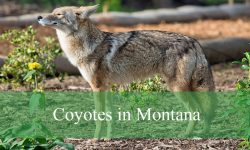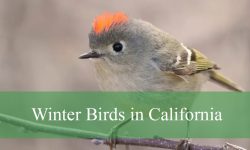Nebraska offers open skies, quiet towns, and gentle farmlands where many dove species find a peaceful home. The soft cooing of the Mourning Dove and the pale beauty of the White-winged Dove fill the state with calm sounds and graceful movement. Each bird adds a touch of serenity to the fields and towns of the Great Plains.
Birdwatchers often enjoy seeing doves perched on fences, walking through farm roads, or feeding near grain silos. Their gentle flight, rhythmic calls, and simple elegance make them easy to admire. Some are common year-round, while others appear only during warm seasons or migration.
This guide introduces seven dove species found in Nebraska, from the familiar Mourning Dove to the rare Inca Dove. Each description includes clear identification notes, feeding habits, and special traits that help you recognize and enjoy these beautiful birds across the state.
Different Types of Doves Found in Nebraska
Mourning Dove (Zenaida macroura)
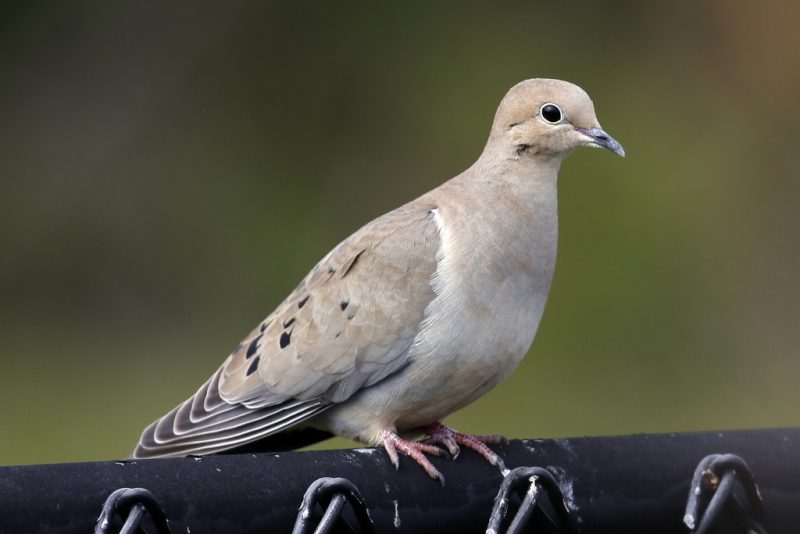
The Mourning Dove is the most widespread and familiar dove species in Nebraska, easily recognized by its sleek grayish-tan body, small black spots on the wings, and a long pointed tail with white tips. Its gentle, mournful cooing call is one of the most recognizable bird sounds in the state, often heard at dawn and dusk. These doves have a streamlined shape and quick, whistling wingbeats when in flight, giving them a graceful appearance as they take off from fence posts or open fields.
Adult Mourning Doves measure about 9 to 13 inches long with a wingspan of roughly 17 to 18 inches. Both males and females look alike, though males tend to have a slightly rosier hue on the chest. Their plumage serves as effective camouflage against Nebraska’s earthy landscapes, helping them blend into agricultural fields and open grasslands. They are lightweight birds, usually weighing around 4 to 6 ounces, allowing them to maneuver swiftly when escaping predators.
Mourning Doves are primarily ground foragers, feeding on a variety of seeds, grains, and occasionally small insects. In Nebraska, they are often spotted gathering spilled grain from harvested fields or backyard feeders stocked with millet and cracked corn. These doves drink by dipping their beaks and sucking up water continuously—a behavior rare among birds. They are also known for their strong site fidelity, returning to the same nesting or feeding locations year after year.
A fascinating fact about the Mourning Dove is their incredible flight speed, reaching up to 55 miles per hour. Despite their delicate appearance, they are strong migrators and resilient survivors. In Nebraska, many Mourning Doves remain year-round, but northern populations may move south during freezing winters. Their soft, haunting coos are a signature sound of summer mornings and a symbol of peace across the plains.
Eurasian Collared-Dove (Streptopelia decaocto)
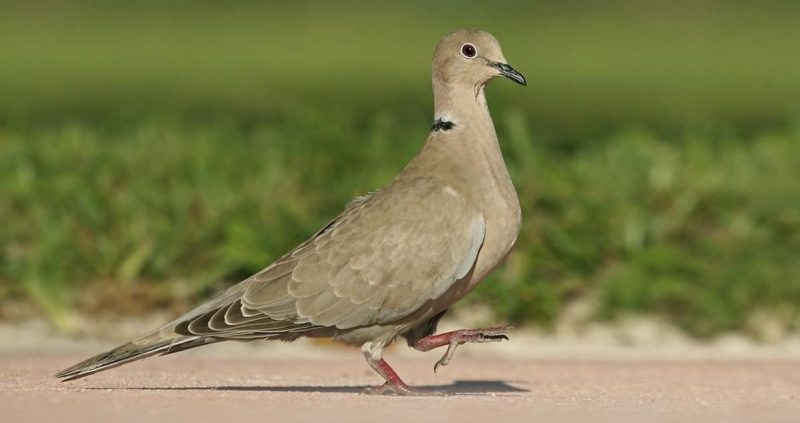
The Eurasian Collared-Dove is a relatively new but now well-established resident of Nebraska. Originating from Europe and Asia, this species spread rapidly across North America in just a few decades. It is easily recognized by its pale grayish-beige plumage, squared tail with white edges, and a thin black collar marking on the back of its neck—its most distinctive feature. Compared to the Mourning Dove, it has a chunkier body and a deeper cooing call, often described as a rhythmic “coo-COO-coo.”
Adult Eurasian Collared-Doves measure around 12 inches in length with a wingspan reaching up to 18 inches. Their plumage remains consistent year-round, and both sexes appear similar. In Nebraska, they are most often seen perched on telephone wires, grain silos, or rooftops in small towns and farming communities. Their adaptability to human environments has helped them thrive across both rural and suburban areas.
These doves are opportunistic feeders, consuming seeds, grains, berries, and the occasional insect. They frequently visit bird feeders, where they may outcompete smaller species. Unlike Mourning Doves, Eurasian Collared-Doves are largely non-migratory and may nest several times each year when weather conditions are mild. Their nests are loosely built from twigs and often placed in trees, barns, or even atop man-made structures.
An interesting fact about this species is its remarkable success story—within only a few decades, it colonized nearly all of North America after escaping captivity in the Bahamas in the 1970s. In Nebraska, its population continues to grow steadily. Their distinctive three-note call and unhurried movements have made them a familiar sight in many neighborhoods, representing one of the most rapid avian range expansions in recent history.
White-winged Dove (Zenaida asiatica)
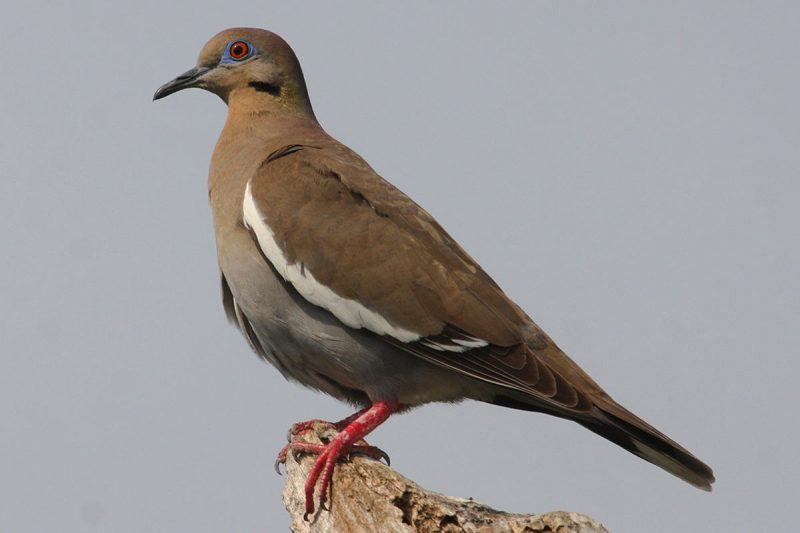
The White-winged Dove is a more uncommon visitor to Nebraska, but sightings have become increasingly frequent, especially in the southern and central regions during warmer months. Larger and more robust than the Mourning Dove, it can be identified by its blue eye-rings, dark red eyes, and the striking white band along the edge of each wing that is visible both in flight and at rest. Their soft, rhythmic cooing has a more tropical tone, often described as a repetitive “who-cooks-for-you” sound.
Adults reach about 11 inches in length with a wingspan of 18 to 22 inches. Their plumage is light brown-gray, and they have black-tipped wings with bold white patches that flash prominently in flight. Males and females look similar, though males may display slightly brighter blue skin around the eyes during the breeding season. In Nebraska, these doves are typically seen in open woodlands, riparian zones, or near agricultural areas with ample food and water sources.
White-winged Doves feed mainly on seeds, grains, and fruits, including sunflower seeds, corn, and wild berries. They are also known to sip nectar from flowers or feed on fruit pulp. During summer, their visits to Nebraska often coincide with favorable breeding and feeding conditions. These doves are strong fliers capable of long migrations, and their northward expansion from the Southwest has led to increasing encounters in the Great Plains.
A fun fact about the White-winged Dove is its strong association with saguaro cacti in the southwestern U.S., where it plays an essential role in pollination. Although Nebraska lacks cacti, the species continues to adapt, using local vegetation for nesting and food. Their growing presence in the state reflects the ongoing shift of bird populations responding to climate and habitat changes across North America.
Rock Pigeon (Columba livia)
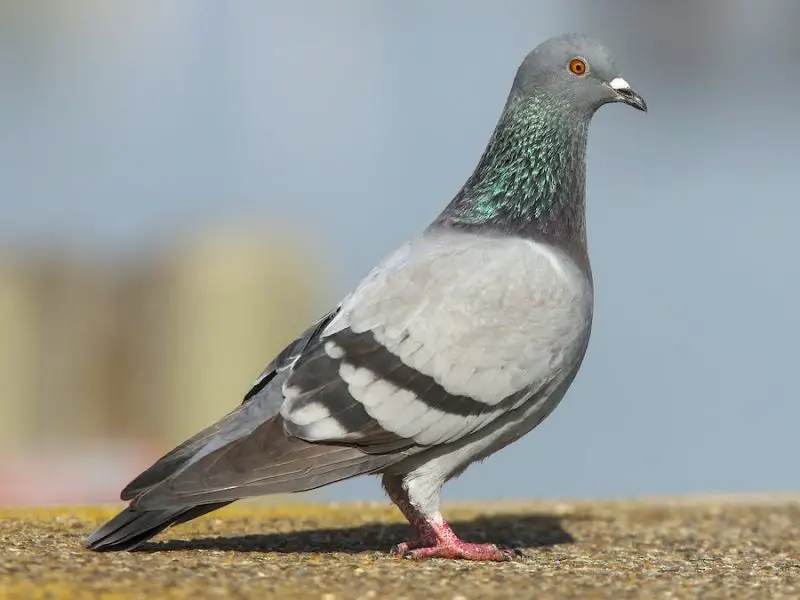
The Rock Pigeon, also known simply as the pigeon, is a familiar sight across Nebraska’s cities, towns, and rural areas. These birds are descendants of domesticated pigeons that became feral centuries ago. They exhibit a wide range of color variations, though the typical plumage is bluish-gray with iridescent green and purple feathers on the neck and two distinct black wing bars. Their sturdy build, short legs, and characteristic “head-bobbing” walk make them easily recognizable even from a distance.
Adult Rock Pigeons measure around 12 to 14 inches long and have a wingspan of 24 to 28 inches. Both males and females share similar appearances, though males tend to display slightly brighter iridescent neck feathers, especially during courtship. Their cooing calls are soft but persistent, often echoing under bridges or building ledges. In Nebraska, these birds thrive in man-made environments, nesting in crevices, roof edges, and underpasses that mimic their ancestral cliff habitats.
Rock Pigeons are opportunistic feeders that consume seeds, grains, and scraps of human food. They frequently gather in large flocks in parks, grain elevators, and public squares, where they have learned to coexist closely with people. Their adaptability allows them to survive in both harsh winters and hot summers, making them one of the most successful urban birds in Nebraska.
A fascinating fact about Rock Pigeons is their incredible homing ability. Historically, they were used as messenger birds capable of returning home from hundreds of miles away. Even today, feral populations retain this remarkable sense of navigation. Their presence in Nebraska’s urban skylines adds a timeless connection between modern cities and the ancient bond between humans and birds.
Inca Dove (Columbina inca) (Rare Visitor)
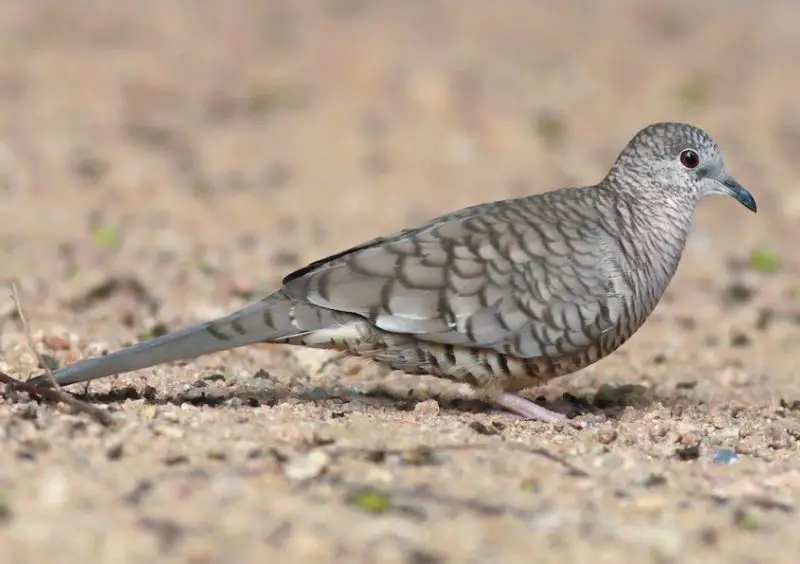
The Inca Dove is a small, delicate species that only occasionally visits Nebraska, usually appearing in the southern regions during mild winters. Its most striking feature is the scaly pattern on its light brown feathers, giving the bird a unique, mosaic-like appearance. The long, slender tail and graceful flight add to its charm, and its quiet, cooing call—often described as a rhythmic “no hope”—has a soft, mournful tone that birders find enchanting.
Measuring just about 8 inches in length with a wingspan of 11 to 12 inches, the Inca Dove is one of the smaller members of the dove family. Males and females look alike, and their plumage blends perfectly with dry, open landscapes. In Nebraska, sightings are typically confined to the southernmost counties or during warmer years when this southwestern species ventures slightly north of its usual range.
These doves prefer open areas such as towns, gardens, and farmlands with scattered trees or shrubs. They feed mainly on small seeds and grains, foraging quietly on the ground in pairs or small groups. Inca Doves are known to form “pyramid roosts” during cold nights, where several birds stack closely together to conserve warmth—a fascinating social behavior rarely seen in other dove species.
A fun fact about the Inca Dove is its remarkable adaptability to urban settings. Though native to arid regions, it has expanded northward by using city parks and suburban backyards as stepping stones. Spotting one in Nebraska is a treat for birdwatchers, as it adds a touch of desert beauty to the state’s diverse avian landscape.
Band-tailed Pigeon (Patagioenas fasciata) (Accidental or Rare Migrant)
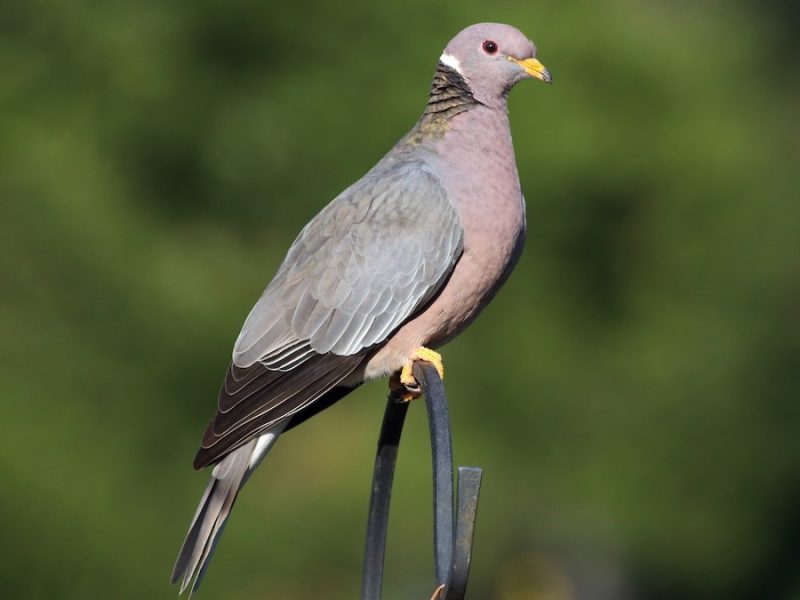
The Band-tailed Pigeon is a rare visitor to Nebraska, occasionally appearing during migration from its usual range in the western United States. This large, elegant pigeon closely resembles a Rock Pigeon but can be identified by its purplish-gray plumage, yellow legs, and distinctive white crescent on the back of the neck. The tail features a noticeable dark band near the tip, which gives the species its name.
These pigeons are among the largest native dove species in North America, measuring 14 to 16 inches in length with a broad wingspan of 25 to 27 inches. Their soft, cooing call is deeper and more resonant than that of the Mourning Dove. While Nebraska lies outside their typical breeding range, stray individuals or small groups occasionally wander into the western parts of the state, especially during migration or unusual weather patterns.
Band-tailed Pigeons usually inhabit mountainous forests and wooded canyons but adapt well to areas with abundant fruit-bearing trees. In Nebraska, when they do appear, they’re often found in wooded habitats where berries, acorns, and seeds are available. These birds feed primarily in the canopy, making them less conspicuous than ground-foraging doves.
A fascinating fact about Band-tailed Pigeons is their close relation to the extinct Passenger Pigeon. Both species share similar social structures and migratory behaviors. Today, the Band-tailed Pigeon stands as one of the last large native pigeon species in North America, and any sighting in Nebraska is a remarkable event for local bird enthusiasts.
Common Ground Dove (Columbina passerina) (Occasional Visitor)
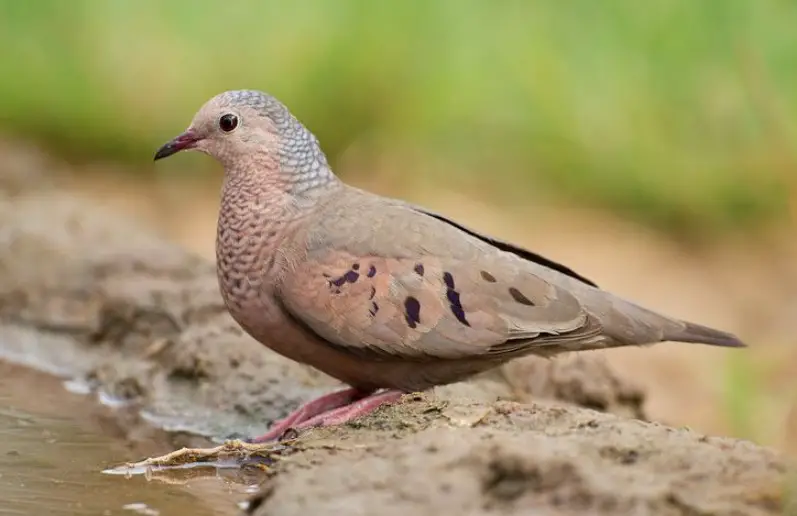
The Common Ground Dove is one of the smallest dove species in North America, and its presence in Nebraska is considered rare but not unheard of. Measuring just 6 to 7 inches long with a wingspan of about 10 inches, this tiny bird is roughly the size of a sparrow. Its reddish-brown plumage, scaled breast, and short, rounded tail give it a distinctive look. When it takes flight, flashes of rusty-red in its wings are often visible, helping birders identify it instantly.
These doves prefer warm, open habitats such as grasslands, sandy fields, and brushy areas. In Nebraska, they are mostly seen during late summer or early fall, typically in the southern regions during periods of favorable weather. Common Ground Doves are shy and prefer staying close to the ground, where they forage for seeds, small grains, and occasionally insects. Their soft, rhythmic cooing adds a gentle charm to quiet fields and prairies.
Unlike many dove species, the Common Ground Dove tends to live a more solitary life, often forming pairs or small family groups rather than large flocks. They nest close to the ground, typically under low vegetation or in open patches of soil, which can make their nests vulnerable to predators. Despite their small size, they are remarkably resilient and capable of surviving in hot, dry environments.
A fun fact about the Common Ground Dove is its surprising toughness. Despite its delicate appearance, it can endure high temperatures and long dry spells by obtaining moisture from its food. Spotting one in Nebraska is a special event, offering birdwatchers a glimpse of a species more commonly found in the southern United States and Mexico.



